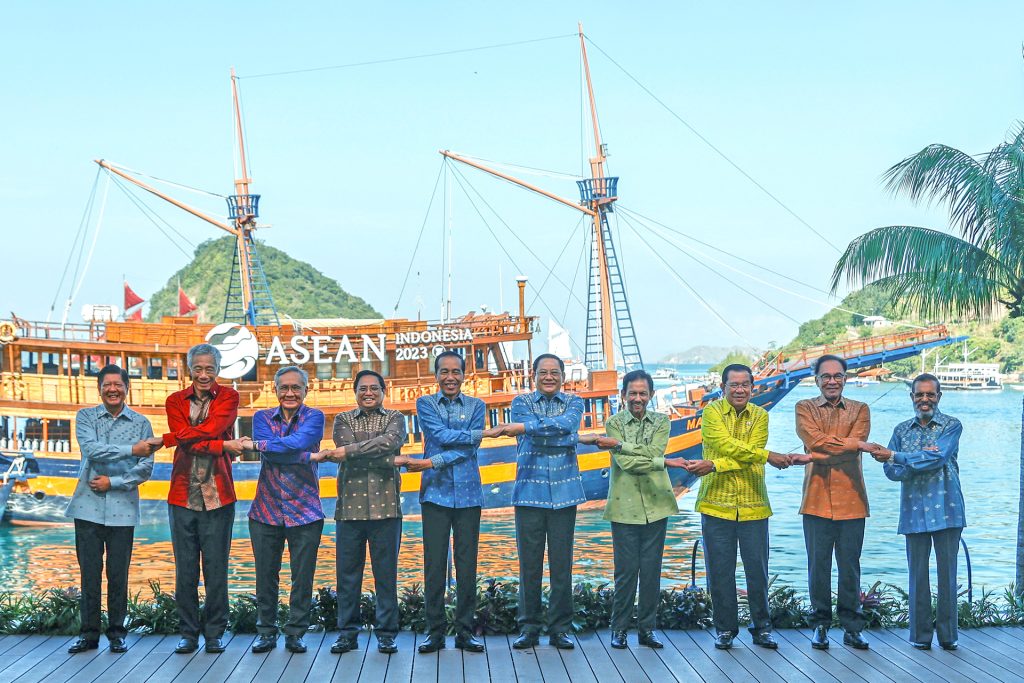Insight Email No. 14
The Cyclone Mocha, one of the strongest cyclones to ever hit the Bay of Bengal, made landfall on the coastlines of Myanmar and Bangladesh on May 14. Its dangerous winds, downpours and storm surge wreaked havoc on 90% of infrastructure in and around storm epicenter in Rakhine State. The impact was also felt in other townships along the storm path, especially in Chin State, Sagaing Region and Magway Region, where substantial rain, flooding and damage occurred. The number of casualties is yet to be confirmed. The State Administration Council (SAC) has declared 17 townships in Rakhine State as disaster areas. The affected population is currently facing urgent needs for shelters, clean drinking water, food, and medicine. Additionally, the restoration of electricity and telecommunications is of utmost importance to facilitate recovery and aid distribution efforts.
This week, ISP-Myanmar is focusing on the 2023 ASEAN Summit and related updates, notable developments following Chinese Foreign Minister Qin Gang’s recent visit to Myanmar, and the Karen National Union’s (KNU) recent congress and response to its resulting statement by the SAC’s peace commission. This email also addresses the prospects of humanitarian assistance and the escalating issue of climate change.
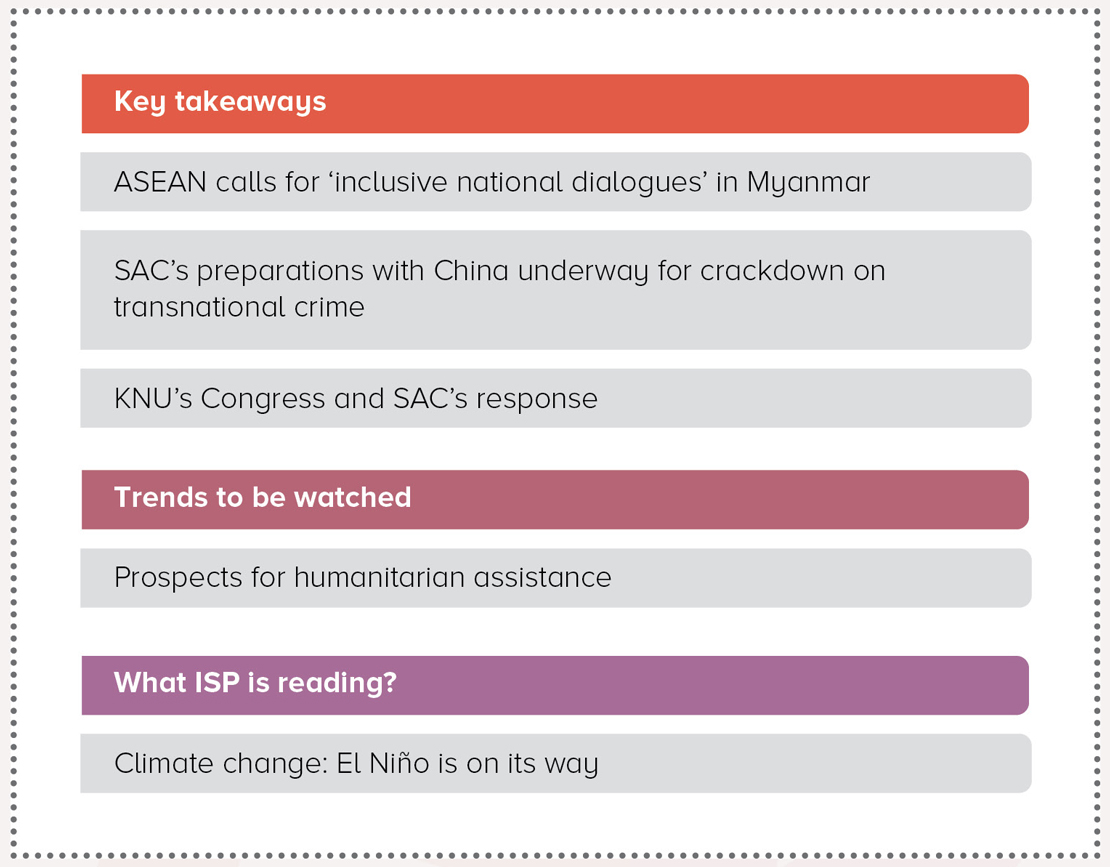
∎ Key takeaways
1. ASEAN calls for ‘inclusive national dialogues’ in Myanmar
The 42nd ASEAN Summit was held in Indonesia’s Labuan Bajo, East Nusa Tenggara on May 9-11. As usual, Myanmar’s junta leader was barred from attending the high-level meeting. Following the summit, ASEAN issued a statement calling for “the immediate cessation of all forms of violence and the use of force to create a conducive environment for the safe and timely delivery of humanitarian assistance and inclusive national dialogues.”
As the crisis in Myanmar has worsened, Southeast Asian leaders became increasingly assertive, and less tolerant particularly in the face of the bloody escalation of the Myanmar crisis, including recent air attacks which have claimed many more civilian lives and further intensified the conflict.
ASEAN’s Alternate Chair, Indonesia’s President Joko Widodo called on the bloc leaders to unite in action, asking “will ASEAN only stay silent or will ASEAN be able to become the driver of peace and growth?” Indonesia has a vision for ASEAN to become an “epicenter of growth.”
Indonesia’s Foreign Minister Ms. Retno Marsudi has stated that while Indonesia is pursuing a non-megaphone approach to diplomacy on Myanmar, that progress is still being made on the issue. Indonesia has organized more than 60 engagements related to Myanmar, including with key partners from the SAC, EAOs, and the democratic opposition,. Meanwhile, a convoy of diplomats from the ASEAN Coordinating Centre for Humanitarian Assistance on Disaster Management (AHA) which was traveling in Myanmar was attacked on May 7 near Hsihseng Township by an unknown group. Fortunately, nobody was hurt. ASEAN has condemned the attack and called for the perpetrators to be held accountable.
The ASEAN Summit statement appears conventional in tone and content. In OnPoint 14, ISP-Myanmar noted that efforts towards resolving Myanmar’s crisis can be seen as two layers with the pre-existing West-led policy layer and ASEAN-led initiative layer but that the problem remains unresolved. Now, as a fresh approach to the Myanmar issue, a new layer of the ‘Neighborhood Diplomacy’ approach led by China seems to be coming to the forefront.

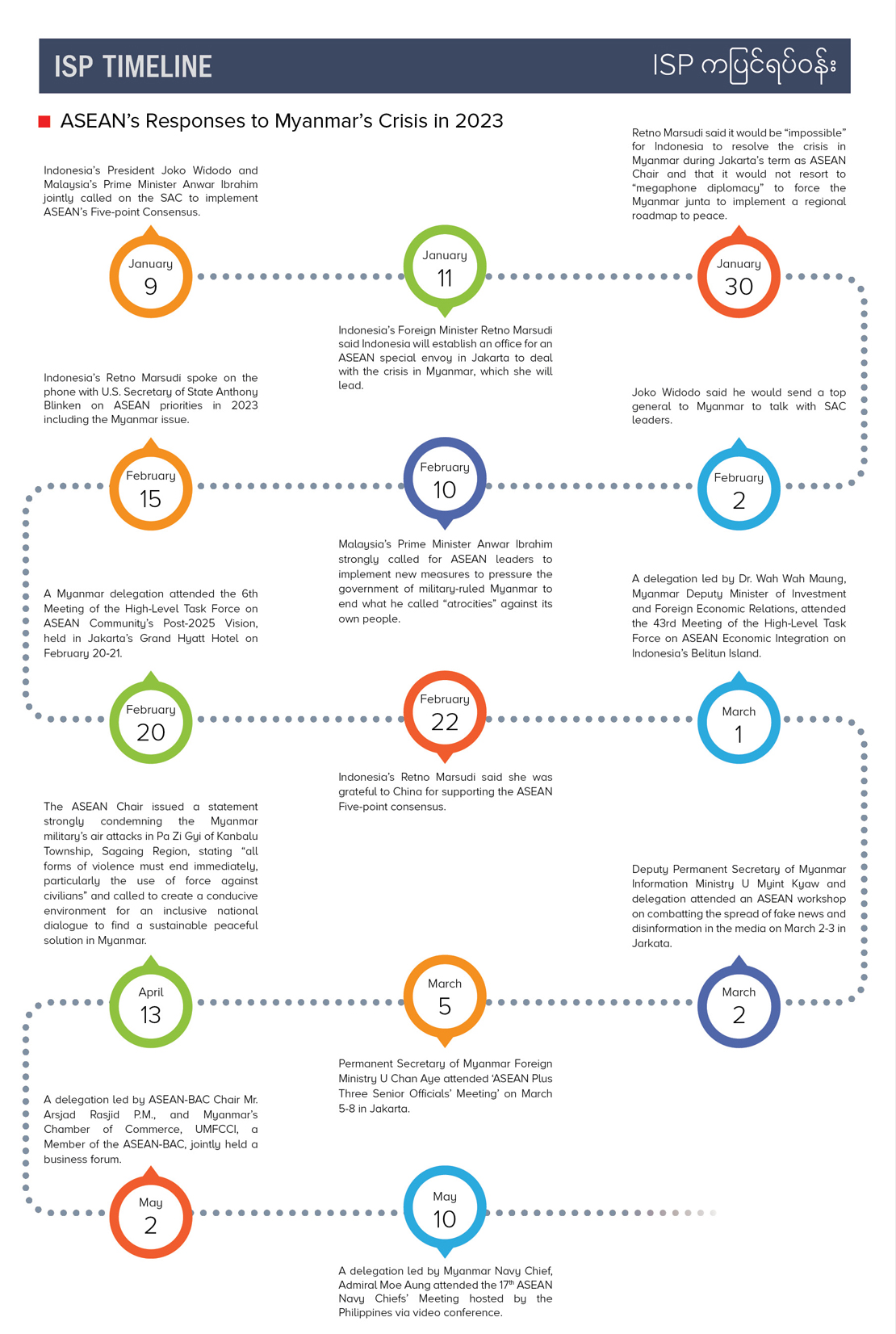
2. SAC’s preparations with China underway for crackdown on transnational crime
Chinese Foreign Minister Qin Gang visited Naypyitaw on May 2 and met with SAC leaders. This visit can be seen as an attempt to reset China’s policy on Myanmar, extend diplomatic ties, and to promote trade and investment in Myanmar, as part of China’s newly introduced ‘Neighborhood Diplomacy.’ It is worth noting that Qin used the trip to emphasize the need to combat transnational crime. Following his visit, ISP-Myanmar has observed some developments in Myanmar, including the authorities’ decision to prohibit foreigners from traveling to border towns and also cracking down on transnational crime. According to a source close to the aviation industry, Myanmar has prohibited foreigners from taking flights to Tachileik and Lashio since May 6 or 7.
In one recent incident of transnational crime enforcement, on May 2 an ethnic armed group from Northern Shan State, Kokang-based forces of the Myanmar National Democratic Alliance Army (MNDAA) executed four Chinese criminals who had collectively allegedly committed 25 crimes including murder, robbery, and abduction. As rule of law deteriorates as a result of Myanmar’s ongoing conflict, transborder criminal activities have broadened. A May 9 press release of the Indian embassy in Myanmar stated “the Indian government evacuated and repatriated three Indian nationals who were victims of job offers from transnational crime syndicates in Myanmar.” Prior to this incident, 330 Indian nationals were assisted in leaving Myanmar and being repatriated to India after suffering similar abuse. In a separate incident, the Indonesian embassy in Myanmar issued a press release on May 6, stating that 20 Indonesian nationals who had been trafficked through Myawaddy Township of Myanmar had been evacuated and repatriated from Yangon to Bangkok.
In February 2, ISP-Myanmar discussed the “Cost of the Coup: The Bricks Have Fallen,” which showed that Myanmar has become a region increasingly monitored for transborder organized criminal activities. The rise of transnational crime triads on the borders of Thailand and China has prompted both governments to attempt to establish and maintain control by cracking down on these activities.
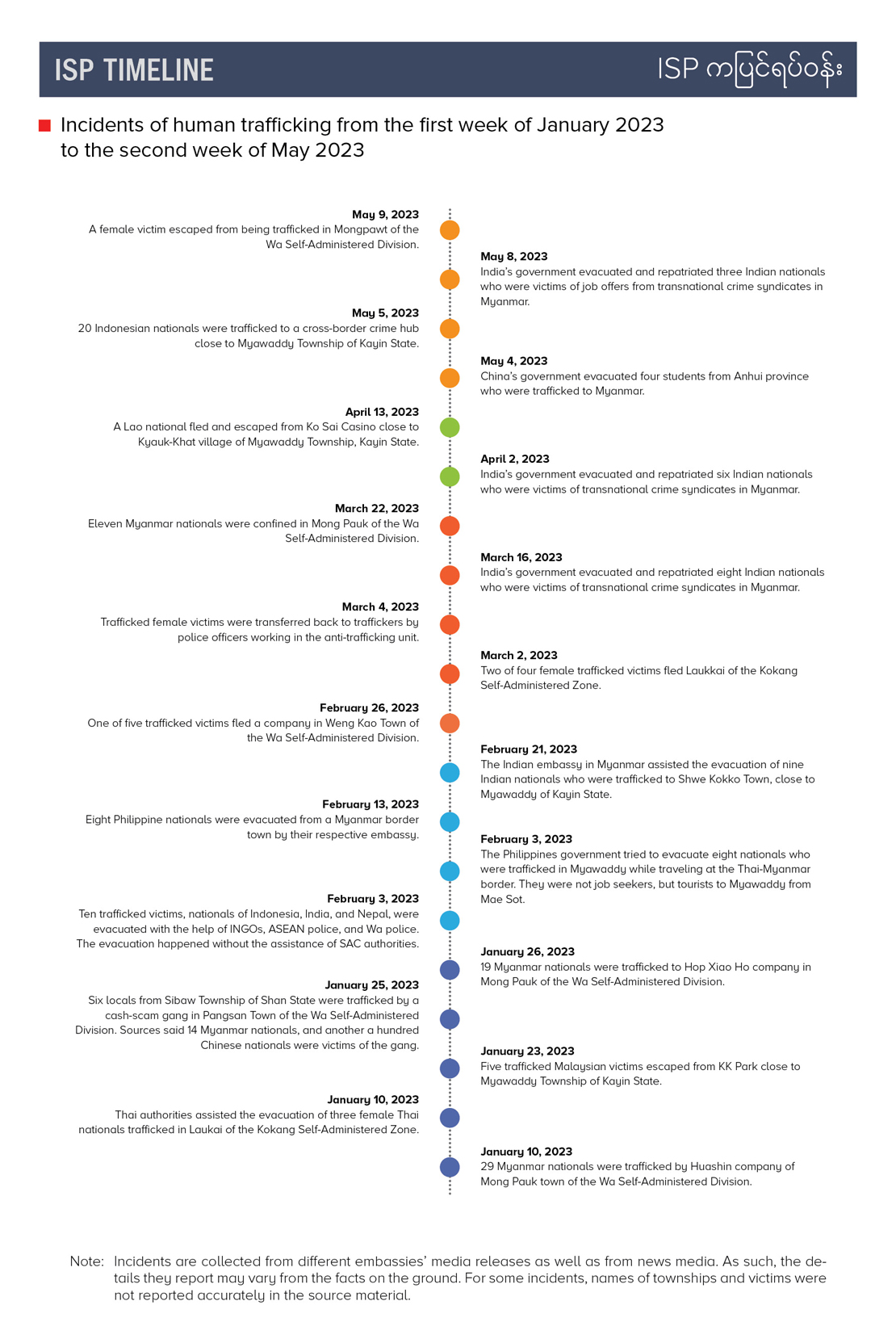
3. KNU’s Congress and SAC’s Response
The long-delayed Karen National Union’s (KNU) 17th Congress concluded on May 5 with the election of a new leadership. The congress had been long overdue and had been postponed several times for various reasons. The new leadership includes Padoh Saw Kwe Htoo Win as Chairman, Padoh Saw Sel Gay as Deputy Chairman, Padoh Ta Doh Moo as General Secretary, Padoh Saw Thaw Thi Bwe as First Joint-Secretary and Padoh Saw Hla Tun as Second Joint-Secretary, among a newly formed forty-five member Central Executive Committee. Some leaders from KNU brigades 2 and 5 withdrew from the meeting demanding that legal action be taken against leaders involved in alleged corruption in KK Park, the trafficking hub in Myawaddy on Myanmar-Thai border.
Following the conclusion of the congress, the KNU released a statement on May 9 affirming “our commitment to combat bigotry and military dictatorship, while also pledging to work alongside democratic and ethnic revolutionary groups, as well as individuals from diverse backgrounds, in their pursuit of a federal democratic union based on the principles of democracy.” On the same day, SAC’s National Solidarity and Peacemaking Negotiation Committee (NSPNC) responded with a statement critical of the KNU’s position stating that it lacked a constructive attitude. The NSPNC also charged that the KNU’s statement was “against the provisions of the Nationwide Ceasefire Agreement (NCA), leading towards confrontation.” The NSPNC statement also criticized the KNU statement saying it “causes hindrances to building the Union … as well as tremendous difficulties for … internal peace, stability, and development.”

The KNU has been a crucial force in the democratic and ethnic movement advocating for self-determination. However, the organization has experienced internal divisions and splits since the fall of its former Marnerplaw Headquarters. The recent split of the Kawthoolei Army (KTLA) led by Nerdah Mya is a clear example of this ongoing issue. It remains uncertain whether the newly elected leadership can reunite these fragmented forces or construct a cohesive vision to mobilize the Karen people. Additionally, both the border and terrain in the region are complex, and Chinese crime hubs such as Shwe Kokko and KK Park continue to destabilize and transform the region. Meanwhile, the KNU faces the daunting challenges of rehabilitating war-torn communities and bringing peace and development to its people.

∎ Trends to be watched
Prospects of humanitarian assistance
Following the ASEAN Summit held on May 9-11, a statement was issued concerning Myanmar, calling “to create a conducive environment for the safe and timely delivery of humanitarian assistance.” However, in a recent incident on May 7, a convoy of diplomats from the ASEAN Coordinating Centre for Humanitarian Assistance on Disaster Management (AHA) was attacked while traveling near Hsihseng Township in Shan State, Myanmar.
Given the protracted and escalating armed conflict, the issue of humanitarian assistance is now a cause for immediate concern. After two years of military rule, the population has endured even greater suffering, resulting in 2.5 million internally displaced persons (IDPs). The provision of humanitarian aid is one of the most pressing issues that can be addressed through the ASEAN Five-Point Consensus, which is currently the most significant development on this front.
Despite the urgent need for humanitarian assistance in Myanmar, there are various challenges that constrain the delivery of aid to those in need. One significant obstacle is the perception that humanitarian aid is being used as a political tool. When international agencies engage with the SAC, it is seen as legitimizing the junta, which undermines the efficacy of aid efforts. As a result, there is currently no stable ground or space for effective humanitarian aid to be delivered within Myanmar, even two years since the coup.
At the other extreme, the SAC’s restrictive policies are a genuine constraint on the delivery of humanitarian aid. The junta regime views aid as a potential source of political strength for opposition forces and intentionally uses a ‘four-cuts strategy’ to create a survival crisis for the local population. In addition, the SAC recently enacted a new ‘association law’ to tighten control over civil society organizations. Even if aid were allowed through, there are still numerous restrictions in place, including the requirement to register with the government in Naypyitaw and the need to deliver funds through formal financial channels which convert via the official overvalued exchange rate. Despite these obstacles, the SAC has insisted on the need for cross-border assistance to reach the most vulnerable populations.
The SAC agreed to a ceasefire on humanitarian grounds with the Arakan Army (AA) in November 2022. While there is no official agreement on this ceasefire and it could be broken at any time, the peace has continued to hold. According to unconfirmed sources, the SAC is said to have adopted a similar ceasefire model for use with other Ethnic Armed Organizations (EAOs). However, even if other EAOs were to consider and apply this model, they could encounter obstacles such as those posed by the divided policy goals of the many resistance groups that have emerged since the 2021 coup.
When it comes to discussing humanitarian assistance, some groups advocate for internationally-led humanitarian corridors. However, this approach may be impractical, and the SAC is likely to reject it. Another suggestion is to hold an international conference, creating an inclusive forum for humanitarian engagement to address emergency situations. Unfortunately, this idea may also not be feasible. There are some who propose a locally-led humanitarian platform that relies on the robust networks of local communities among ethnic populations and works through grassroots efforts. However, implementing such an approach would require tolerance, open-mindedness, negotiation, and the creation of a conducive environment that ensures safe and timely delivery of assistance to address Myanmar’s emergencies. Following the ASEAN Summit, it remains to be seen how effective and timely the ASEAN Coordinating Centre for Humanitarian Assistance on Disaster Management (AHA) can be.
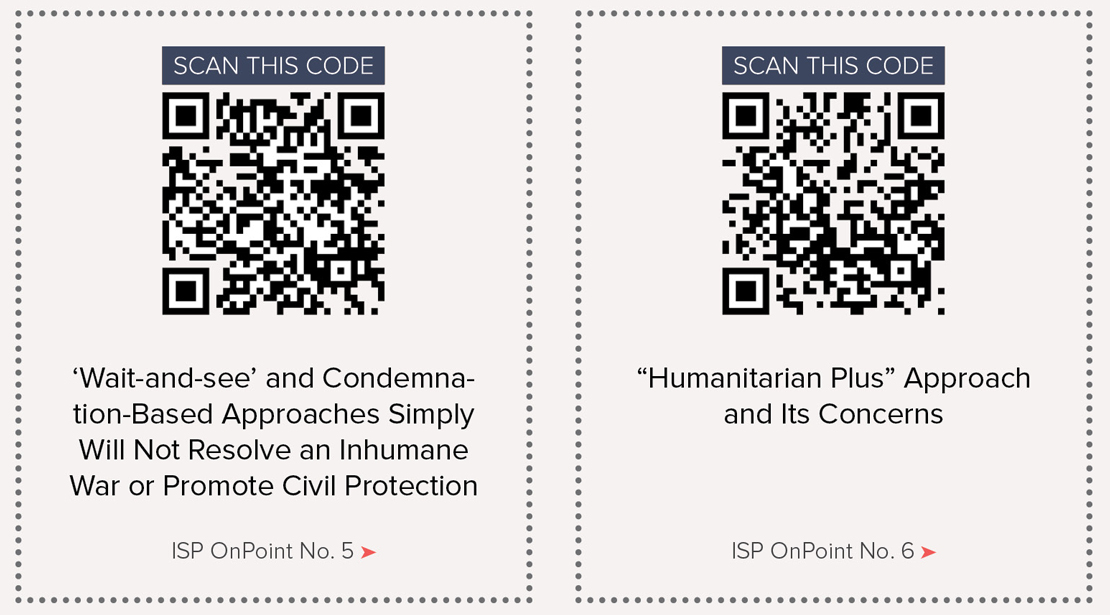
∎ What ISP is reading?
Climate change: El Niño is on its way
In the Pacific Ocean, there are natural phenomena known as La Niña and El Niño. The late meteorologist of Myanmar, Dr. Tun Lwin, explained that El Niño brings hot and dry weather, while La Niña brings cold and wet weather. These opposing phenomena have a significant impact on weather patterns across the globe.
The shift from La Niña to El Niño and vice versa typically occurs every two to seven years, and once the shift occurs, the altered weather patterns can persist for nine to 12 months. Experts have cautioned that the upcoming El Niño event could last for up to three years.
The irregular and long-running La Niña—cold weather in the Pacific Ocean— that has occurred since 2020 has now completely ended. As a result, the development of an El Niño is highly probable, which could result in a new surge in warmer regional and global temperatures and a spike in maximum temperdatures likely to break the records. The World Meteorological Organization (WMO) has issued a warning, stating that there is a 60% chance of a transition from ENSO-neutral to El Niño during May-July 2023. This likelihood is expected to increase to 80% between July and September 2023.
The rapid development of El Niño could bring severe and unprecedented impacts on many parts of the world. As reported by CNN’s Climate Crisis report on April 1, there are six weather and climate extremes to watch for:
1. The world could breach 1.5 degrees of warming for the first time.
2. Higher temperatures mean many more places will encounter drought, extreme heat, and fires.
3. There could be more drought-busting rain in the Western Pacific.
4. The Pacific Ocean’s warmer waters will fuel stronger typhoons.
5. The warm seawater will cause catastrophic bleaching of coral reefs, which are an important marine habitat. Coral reefs also protect coastlines from storms and erosion, and provide jobs for local communities.
6. More Antarctic ice will melt down dramatically. These developing weather patterns of El Niño have been reported by the BBC Burmese section, VOA Burmese, and other Myanmar news agencies. The natural resources and environment ministries of neighboring countries are also warning of possible consequences.


